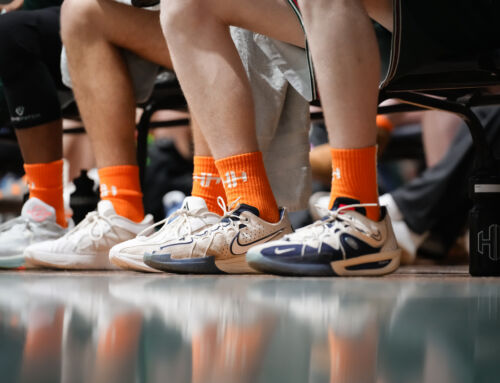FUN FACTS
THE SNEAKER EVOLUTION
The earliest sneaker was manufactured by the Liverpool Rubber Company back in the 1830s. Canvas uppers were bonded to rubber soles to make comfortable, nonslip shoes that people began wearing to places like the beach. The mid and late 1800s and early 1900s saw the explosion of leisure time activities like going to the beach and even an explosion of sports. In 1917, Converse released the first sneaker designed for basketball, the Converse All-Star. By the 1920s the Liverpool Rubber Company was making specialized sneakers, including one specifically made for playing tennis.
Converse and the Early History of Basketball Sneakers
- The Converse Rubber Shoe Company was founded in 1908.
- An early version of the All-Star basketball shoe was released in 1917 under the name non-skids and was designed for basketball players.
- A semi-professional basketball player named Chuck Taylor went to work for Converse as a salesman in 1921. Along with selling the shoe, he had ideas about improving it. For example, how to improve the flexibility of the sole while also making changes to provide more ankle support. The shoe adopted the All-Star logo over the ankle at this time.
- Taylor hosted basketball lessons and clinics across the country and sold shoes as he taught. He also played for and managed a team known as the Chicago Converse All-Stars who promoted the shoe.
- All-Stars became the official shoe of the Olympics in 1936 and remained in that position until 1968.
- During World War II they were the official training shoe of the United States Armed Forces.
- Converse fell out of favor with basketball players in the 1960s.
- Since the 1980s, Converse has been a popular choice for a fashionable sneaker with retro appeal.
The 1970s: The Golden Age
- Converse attempted to stay current by adding more color options (until the 1960s Converse were only sold in white or black) and updating the rubber sole.
- Improvements in sneaker technology meant that Converse’s long era as the reigning sneaker of professional basketball players was coming to an end.
- Puma worked with New York Knicks star player Walt Clyde Frazier to design and release The Puma Clyde. Featuring a suede upper and wider sole to improve the stability of the foot.
- Nike released two basketball sneakers in the 1970s. The Bruin in 1972 and the Blazer in 1978. Both featured distinctive leather uppers.
The 1980s: Nike Dominates
- During the 1980s many more manufacturers began making basketball sneakers, and many more basketball players signed on to endorsement deals. However, Nike dominated the decade.
- The first major release was the Air Force 1 in 1982, which was worn by players like Moses Malone.
- Nike partnered with Michael Jordan in 1985 when it released the first Air Jordan. The second version of the shoe, the Air Jordan 111, was released in 1988.
- Other sneaker brands, like Reebok and Ewing, also began issuing basketball sneakers during the 1980s.
The 1990s: New Stars Emerge
- The Reebok Pump was released in 1991 and spotlighted at the 1991 NBA Dunk competition where they were worn by emerging stars like Celtics player Dee Brown, who won the Dunk that year.
- Kobe Bryant emerged as a new star in the NBA and endorsed the Adidas Crazy 8.
- Nike released new versions of the Air Force One and Air Jordans.
The 2000s: Rapid Advancements in Sneaker Technology
- Nike introduced Shox technology when it released the Shox BB4 in 2000.
- Lebron James wore the Nike Air Zoom Generations when the shoe was introduced in 2003.
- Sneaker manufacturers took advantage of new technology and scientific knowledge to begin designing and selling shoes specifically designed for playing basketball that were cutting edge and reduced fatigue for players. This also meant that the schedule for sneaker launches sped up and more basketball sneakers entered the marketplace each year.
- Significant sneaker releases of the 2000s include the Nike Kobe V, the AdiZero, the Lebrox X, the Nike Kyrie 1, the Nike Kobe 9, and the Nike Lebron 15.
- Sneaker companies also began releasing more special editions of sneakers, often tied to current events, fads, or historical events. For example, Nike has released special editions of shoes in honor of Black History Month.
- The 2000s have also seen the growth of sneaker culture. Sneakers now have a dedicated fandom full of collectors. Often, special editions of basketball shoes sell out within minutes. Sneaker culture has also gone mainstream and the design and history of sneakers have been the subject of exhibits at The Design Museum, The Brooklyn Museum, and the BATA Shoe Museum.
FUN FACTS PROVIDED by Dylan and his Dad.






